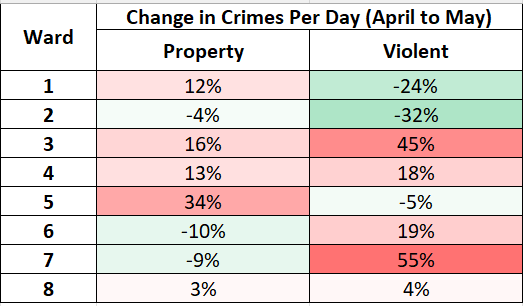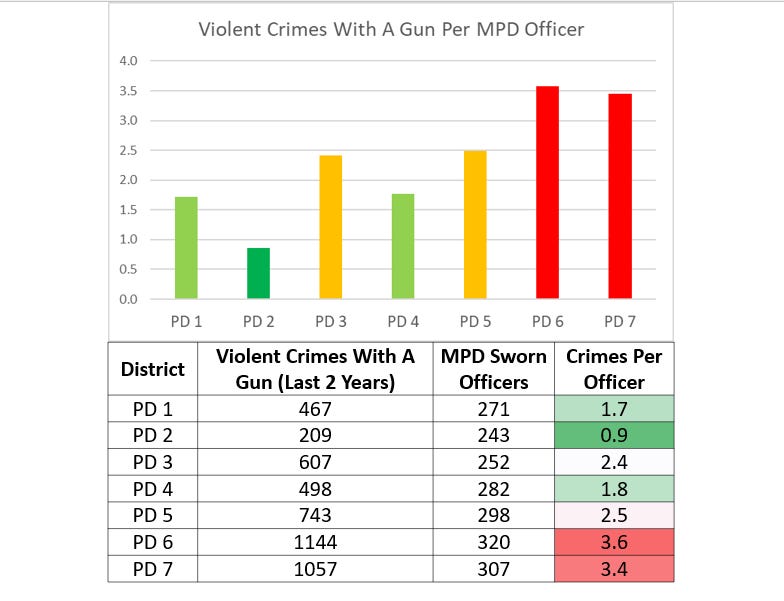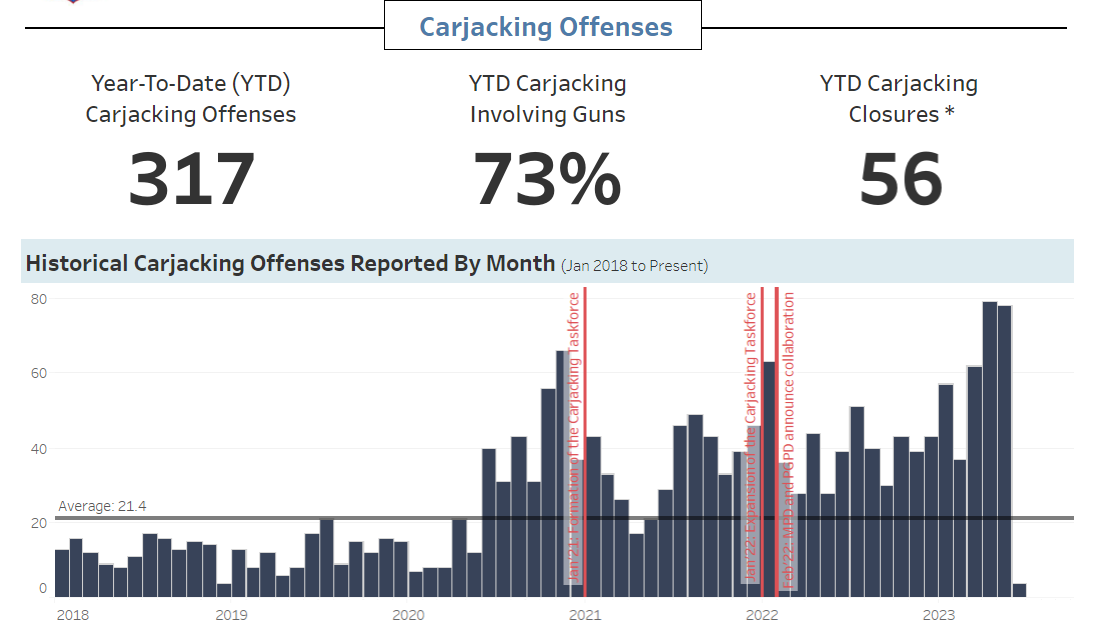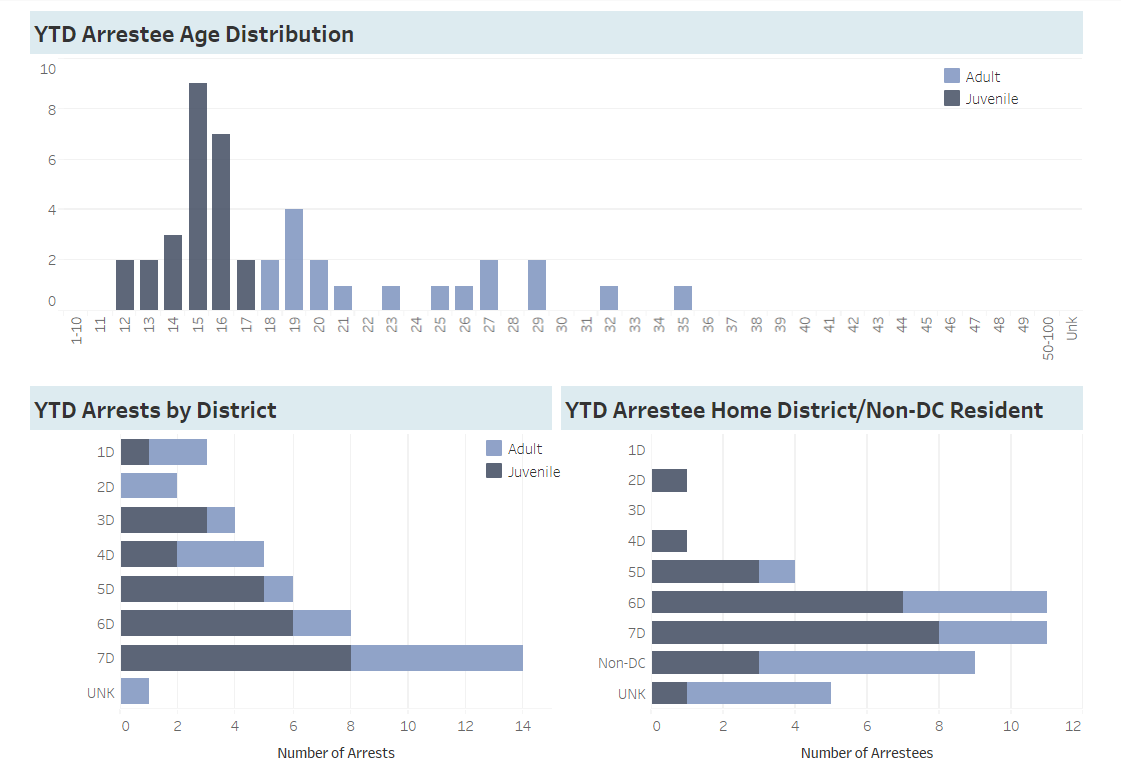Monthly update: Crime rose 6% in May
Motor vehicle theft and homicides increased significantly
Overall reported crime in DC rose by 6% in May compared to April with unfortunate increases in homicide and motor vehicle theft:
Property crime (~85% of all reported crimes) rose by 6.2%, driven by a 23% increase in motor vehicle theft
Motor vehicle theft actually surpassed “theft from auto” as the 2nd most common crime in DC (behind the generic category “theft/other”)
Violent crime rose 5.4% with a 6% increase in robberies and an awful 55% increase in homicides
2/3 of DC’s homicides this year have been in wards 8 and 7; where MPD has assigned less experienced officers and proportionally fewer officers
Ward 7 saw a 55% increase in violent crime in May
Crime fell by 1% in the Business Improvement Districts (BIDs)
April had an unusually large number of “late reported” crimes, with the crimes per day rising from 79.6 to 87.6 since the last time we pulled data from DC Crime Cards in early May.
Relative to the pre-COVID baseline, crime in 2023 is ~10% lower but key categories like homicide and motor vehicle theft are significantly higher
Now with more data from April and May it appears that the relative decrease in March was just a temporary blip. I was surprised by how many April crimes weren’t reported until later in May and this “lag” is something I want to be careful about since it can skew the most recent month’s data. I prefer to produce these monthly updates close to the beginning of the new month so that it’s “fresh” but I don’t want to portray an overly-rosy picture:
Ward level data can be very “noisy,” especially violent crime rates in relatively low-crime areas where 1 or 2 crimes can be a large % shift. The large reductions in violent crime in wards 2 and 1 are welcome but the biggest story is the 55% increase in Ward 7. In raw numbers Ward 7 went from 2.2 violent crimes per day in April to 3.4 in May and was higher than Ward 8’s 3.0 violent crimes per day:
Homicide rose 55% in May and it remains overwhelmingly concentrated in wards 8 and 7. When talking about DC’s 15% YTD increase in homicide it’s important to remember that ward 8 has been hit the hardest by far. Across the other 7 wards homicide is flat (still too high but no worse than 2022) while in ward 8 homicide is up 44% YTD:
This enormous disparity in violence, with 2/3 of DC’s homicides in wards 8 and 7, is why MPD’s staffing strategy (which does not prioritize these areas) is so perplexing. Recall that police district 7 mostly overlaps with ward 8 and police district 6 mostly overlaps with ward 7. MPD’s own report (which I wrote about in this post) found that districts 6 and 7 had significantly less-experienced officers than the rest of DC:
This is mostly due to experienced officers using their seniority to get out of these districts but MPD is (apparently) not making much effort to rotate experienced officers back in. Research shows that more experienced officers help reduce crime and it’s confusing that MPD is deploying its experienced officers to the less violent and lower crime areas of DC.
That same MPD report noted that community feedback from residents in wards 7 and 8 detailed worse experiences with MPD officers, harming community trust and cooperation in investigations. This also unfortunately leads to these areas receiving fewer MPD resources:
“Participants from majority-Black Wards 7 and 8 said they had historically experienced an aggressive and disrespectful style of over-policing not seen in other wards. Some participants recalled witnessing rudeness in MPD officers’ tone, language, and conduct. They also cited some officers’ lack of empathy and kindness.”
“Many community members said they felt their neighborhood was being policed inequitably, and some residents have stopped calling MPD since they anticipate the response would be inadequate. One resident described how MPD only drives by when called and often after a long wait, which allows suspects to hide and resume their criminal activity once MPD leaves. But 911 call volume influences where MPD chooses to spend its proactive patrol time, so when 911 call volume does not reflect the rate of crime and public disorder, a community is unlikely to receive the level of police engagement needed for residents to feel safe or to have trust and confidence in their police department.”
This reduced 911 call volume seems to have contributed to MPD relatively understaffing districts 7 and 6. This leads to a situation where the areas that are driving DC’s homicide rate receive proportionally fewer officers, those officers are less experienced and those officers have a worse rapport with the community. It’s up to Mayor Bowser and MPD to change that dynamic, in partnership with community leaders.
Crime fell by 1% in DC’s Business Improvement Districts (BIDs) with 7 of 11 BIDs seeing decreases. Adams Morgan and the Capitol Riverfront had the largest increases of about 0.6 crimes per day:
With motor vehicle theft rising significantly this month (and having been well above the pre-COVID baseline for a while) I wanted to look at this crime and carjacking specifically. In legal terms, “Carjacking is different from auto theft in that carjacking requires more proof that the person actually took the vehicle from someone else’s possession and used physical force or violence in taking it.” MPD doesn’t identify which crimes are carjackings in DC Crime Cards (depending on the circumstances I believe it can be coded a robbery or motor vehicle theft) but they do have a pretty good carjacking dashboard:
The first thing to note is that motor vehicle theft is far more common. There have been 2,919 motor vehicle thefts YTD while there have been 317 carjackings. So you are ~9 times as likely to have your car stolen without you being in it than you are to be carjacked. Geographically, the distribution is pretty similar though with far more data points for motor vehicle theft:
One key problem in combatting carjacking is the relatively low 18% closure rate. We need to be fair to MPD because some of these cases can be very difficult to prove. Unfortunately, the low closure rate almost certainly encourages criminals to engage in more carjacking. Hopefully MPD is researching if other departments have tactics that have helped them successfully arrest and prosecute carjackers.
Of the suspects that MPD does arrest, a 58% majority of them are juveniles and anecdotally this is a big change from the pre-COVID years. It is pretty likely that this is not representative of all carjacking suspects and simply reflects that juvenile carjackers are easier to catch. Among this (probably skewed) sample of arrested carjacking suspects, 1/3 are from outside DC and 51% are from police districts 6 and 7:
We do know that in absolute terms there are many more carjackings (than pre-COVID) and that MPD is arresting more juvenile suspects. Unfortunately the low closure rate means we can’t be sure if it is juveniles predominantly causing the overall increase in carjacking. A lot of the media coverage of carjacking focuses on juveniles but there are also a lot of adult carjacking suspects on the loose and they warrant attention as well.
Carjacking has also had a lot of political impact, with some proposed reductions in carjacking sentencing guidelines becoming one of the most-cited reasons for Congress and President Biden to overturn DC’s revised criminal code. Unfortunately, the March 20th repeal of the criminal code overhaul doesn’t seem to have “sent a message” to carjackers; with DC instead having its highest # of carjackings ever in April and its 2nd highest in May. Of course it’s not likely that criminals were following the news about complicated sentencing guidelines that were set to take effect several years in the future; and more mundane policing, prosecution and prevention efforts will be necessary to bring down DC’s carjacking rate. So long as the closure rate is as low as 18% (and charges are then subject to the USAO or DC Attorney General’s proclivity to drop or reduce them) we should be skeptical of politician claims that “harsher sentences” will deter carjackers to any meaningful degree.
As I said last month (and will likely continue to repeat) these month-over-month changes largely do not reflect larger policy debates about crime. There have been no significant changes in law, policing, prevention or the economy that obviously map to the ~6% increase in crime in May. The weather was warmer by ~2.9 degrees and that does usually correlate with an increase of 1.6 crimes per day. However, crime in DC rose by 5.3 per day; so the weather only “explains” some of May’s increase. Beyond crime rates, here is a very quick roundup of key developments:
Mayor Bowser’s crime proposal: Mayor Bowser proposed a number of changes to sentencing guidelines, pre-trial release, DNA evidence collection, GPS surveillance and other “gaps” she cites in the justice system. The bill that she sent to Council is here and the first hearing is scheduled for June 27th.
MPD Chief transition: Mayor Bowser announced that Ashan Benedict would serve as interim chief after Chief Contee’s retirement in June. MPD also launched a survey for residents to share their priorities for the new MPD chief here: https://mota.dc.gov/chief
New Deputy Auditor for Public Safety: Chris Magnus, a former police officer and police chief, was selected to be DC’s first Deputy Auditor for Public Safety. He did an interview with WAMU reporter Jenny Gathright about his new role.
School Resource Officers (SROs): The DC Council approved the Fiscal Year 2024 budget that repealed the previously-passed phaseout of SROs.
Sentencing Commission Report: This late April report did not get much media attention but it provided updated data on high USAO declination rates:
46% of felony arrests by MPD were declined or “no papered” by the USAO. Another 11% of felony arrests were charged but then dropped; so in total at least 57% of MPD’s 2022 felony arrests went nowhere. There were similar declination and “case dropped” rates for illegal gun charges (CPWL).
Very concerning internal MPD report: MPD posted “A Cultural Assessment of the MPD Workplace” that I wrote about here:















"...it’s confusing that MPD is deploying its experienced officers to the less violent and lower crime areas of DC."
Is part of this retention? I can see why from a policing perspective, you'd want experienced officers in higher crime parts of DC. But from a labor/retention perspective, if senior officers can credibly say they'll quit and transfer to a nearby low-crime jurisdiction in MD or VA, it's understandable why MPD might concede and allow more senior officers to go where they want within DC.
[Not at all sure on this, but I am assuming nearby jurisdictions would find senior MPD officers as appealing candidates to hire, and they have open spots to hire. Maybe senior MPD officers would require a high salary so they're less appealing, or maybe for pension reasons they don't really want to leave MPD and start over with a new police force.]